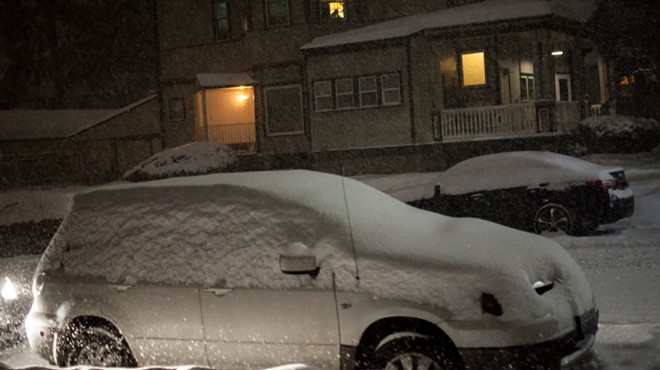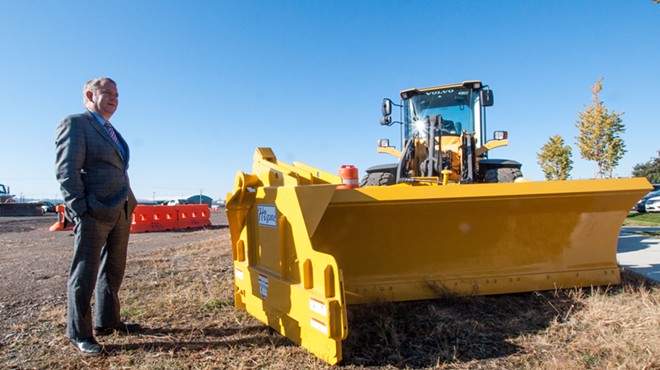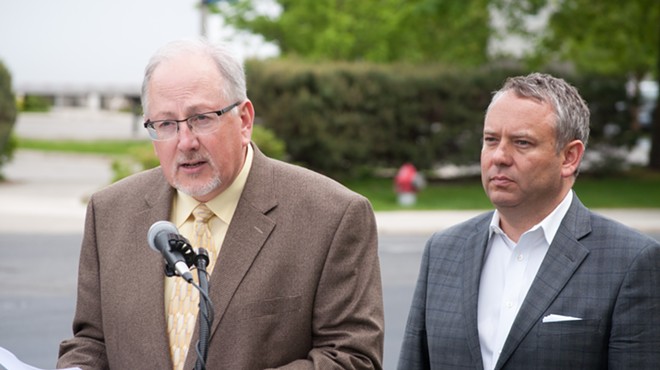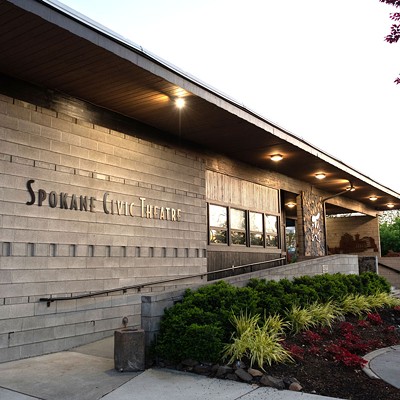Tuesday, February 28, 2017
Six pothole-fixing ideas from the city's recent flurry of experimentation
Councilwoman Amber Waldref also wants the city to revamp its snow-plowing strategy
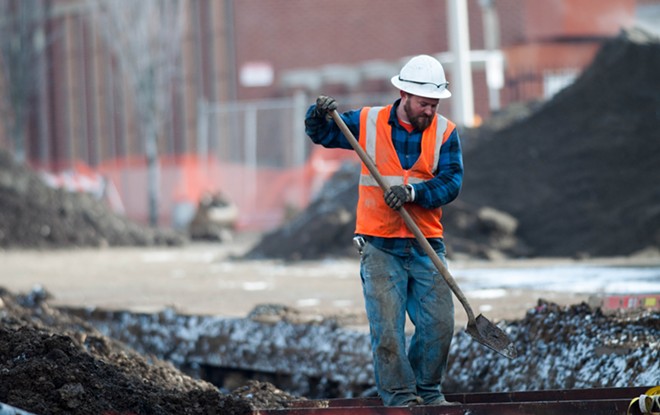
Daniel Walters photo
The wholesale replacement of streets — like this one at First and Cedar — continues to be a long-term strategy to fight potholes.
In the aftermath of the ouster of streets director Mark Serbousek on Feb. 2, the city went largely silent about the street department. It turned down multiple requests for sit-down interviews from the Inlander — including with new interim Street Director Gary Kaesemeyer, Public Works & Utilities Division Director Scott Simmons, and city spokeswoman Marlene Feist.
The initial response from Simmons — that the Inlander should check in again on the street department in six months — suggested it could be a very long time before the city divulged more about how it was operating the department.
But on Friday, the city veered in the other direction, with an all-hands-on-deck press conference featuring Simmons, Kaesemeyer, Mayor David Condon and Amber Waldref. While they continued to refuse to answer any questions about Serbousek's ouster specifically, they painted the scene of a flurry of experimentation over the past three weeks.
At times, City Council President Ben Stuckart has said that he's been frustrated by the pace of innovation in the street department — though he also says that sometimes the department may be unfairly blamed for decisions elsewhere in the city that stymie innovation.
But in the span of only a few weeks — after the last big snow plow finished and the melting snow revealed a series of massive craters in the streets — under Kaesemeyer's new leadership, the department has undergone a flurry of innovation and experimentation intended to strike at one of Spokane's oldest punchlines: potholes.
"The innovative approaches that the team has come up with has really been a grassroots efforts by employees," Simmons said at the press conference, "They've been the ones identifying, how we might go out and tackle this thing."
While the traditional methods had been effective in past years, the sheer amount of moisture under the roads has exacerbated the issues with the city's freeze-thaw cycles.
"There's no better time than when you went through some trial by fire, when things were tough," Simmons says. "It's allowing us to make sure were not being complacent."
It was like a perfect storm, but, you know, for weather.
"The wettest October, in decades," Condon says. "The coldest January, in decades. Those two pieces together."
The severity of the season, Kaesemeyer says, presented an opportunity to seize upon the knowledge the department already had. They'd had other experiences in other cities. They had friends in other departments in other states. And they had plenty of ideas of how to solve Spokane's pothole crisis.
"We'd be sitting in a meeting and have crews come in and saying, 'hey, I had this spot here while I was driving around in the truck today,'" Kaesemeyer says. "We're getting good ideas from all kinds of places. A lot of citizens are calling in, saying, 'hey we did this, we did that.' I had a person from Alaska stop by the other day, saying, hey, used to do this up in Alaska."
By Friday, the city presented a wide range of potential solutions — and experiments — to tackle the pothole crisis.
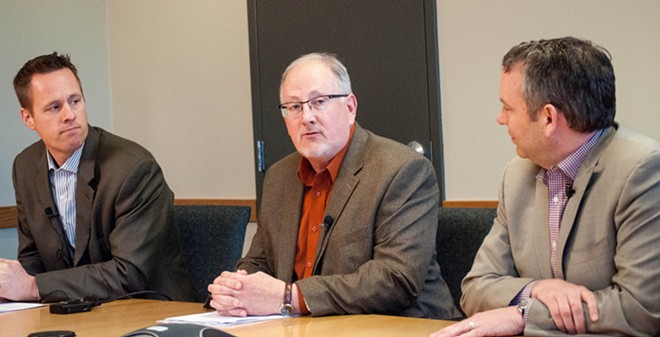
Interim streets director Gary Kaesemeyer (center) is flanked by Public Works & Utilities Division Director Scott Simmons (left) and Mayor David Condon as they outline the city's pothole-filling strategy.
1) Team up with the water and wastewater departments.
Before becoming the interim street director, Kaesemeyer actually served as the superintendent of wastewater collection and maintenance for the wastewater department. And that, Simmons says, has been helpful.
"Gary has been working and diving into what our operations look like, how we might continue to do things differently going forward, engaging employees in a lot of levels," Simmons says. "He brings ideas over from wastewater, in terms of how they've done things. And just being able to see the lay of the land, in terms of what resources might be available. We've seen some really good integrated effort that he's brought to integrated departments."
That has extended to tapping into the labor force in the wastewater and water department. Two-person teams from the other departments are going out with street teams in an attempt to more quickly solve potholes.
"We're trying to be smart about how we actually spend dollars for our citizens," Simmons says. "The answer isn't always, 'hire more,' the answer is, 'do we have resources elsewhere in the city that can get us to the same outcome or a better outcome?'"
2) Test out new pieces of pothole-repairing equipment.
There's a machine that's been used in Idaho and Oregon that's almost an all-in-one pothole-patching gizmo. City Spokeswoman Marlene Feist says that it can both blow out the water and debris out of the pothole and fill it with an emulsifier/aggregate mix. The city plans to test it out to see if it's effective on Spokane streets.
"Innovation and technology is always advancing and always bringing new solutions to bear," Simmons says. "This is one we're evaluating and bringing to the forefront to make sure that it works.
3) Run experiments with different materials on the same stretches of road.
It can be a little tricky to determine which material is best to use in Spokane. The ground underneath Freya Street and the ground underneath Maple Street may differ significantly.
For example, they'll try out using a polymer bridge-decking material — which is a little more like cement — in some problematic areas. The question is how it will work filling in with existing asphalt.
"We're going to see whether that becomes cost-effective in the long-run," Kaesemeyer says. So far, it's working well. The mix seems to be holding."
4) Help a local asphalt plant start up early, and buy its hot asphalt mix.
Generally, cold-mix asphalt is used for filling potholes in the winter and hot-mix asphalt — which needs a higher temperature to settle — is used during the summer. As a result, local asphalt plants often shutter during the winter.
But here's the thing: With the amount of moisture soaked into the streets, the cold mix has been failing. The city has watched already-filled potholes collapse or pop out. So the city plans to start using the hot mix during the winter, and use artificial means — like propane torches —to heat it up so it will adhere.
The city will subsidize the local Inland Asphalt plant $1,000 a day to keep it running in order to purchase hot-mix asphalt.
"We've never had the chance of having hot-mix in the winter," Condon says. "Now the availability of that will facilitate the process."
Inland Asphalt is reaching out to Spokane County and Spokane Valley as well, to see if they want to use hot-mix as well.
4) Tracking the success of pothole-filling using the city's GIS system.
Condon has always been a bit of a data wonk, using things like "performance measures" to judge, say, how fast the city has been responding to its severe potholes. But Condon says that by tracking exactly where the problematic pothole places are, the city can see whether its strategy has been working or not.
5) Examining switching out the order of street-repair to tackle the most damaged streets first.
The city will take a good look at its grind-and-overlay schedule to rework its medium-term strategy for fixing damaged streets. The city wants to be more flexible to make sure that the streets that need the most help get that help the fastest.
6) Keep pursuing the city's long-term strategy comprehensive strategy
This fall we put out a story called "How Spokane Beat Potholes," which may seem a little ironic considering the war-torn appearance of some of the streets currently. But the city says the central thesis of the story still holds. The long-term strategy, which includes a wholesale reconstruction of, not just the streets, but the stuff under the streets. It's a strategy that includes using vegetation and swales to redirect water and avoid the stormwater drains.
By doing everything at once, the city avoids needing to break up the street constantly to fix pipes or add new electrical lines. And keeping the asphalt unbroken, the city prevents water from seeping into cracks in the pavement, freezing, and creating potholes.
The city says the strategy is working. The streets that have undergone the full rehab have not seen the same sort of pothole devastation as the older streets.
Thanks to the 2014 street bond and the decision to connect the utilities budget with the street budget, the city has at least $5 million more a year to spend on streets.
At the Public Works Meeting on Monday, Councilwoman Amber Waldref presented a draft of a resolution asking for the city and council to do a full-scale reassessment of the street department's snowplowing plan.
"We're hearing from the community, well, there's not enough resources," Waldref says about the city's snowplowing strategy. "Well, I'm the one who's supposed to allocate those resources. That's why I'm like, 'woah, Scott, do we have enough resources?'"
Waldref wants to figure out if the city-wide plowing time could be reduced and if snow-removal around "high-density areas like Downtown Spokane, and around schools and medical facilities" can be improved. Waldref also suggests considering borrowing equipment used by Spokane Airport, Fairchild, and surrounding municipalities when necessary.
The council members in attendance also expressed support for a proposal to create a "bridge engineer" position, intended to be filled by former Street Director Serbousek once he goes through the civil service process.
"I think he will do a great job in that position," Simmons says. "I have a great deal of confidence, otherwise I wouldn't be proposing this position."
It suggests that, while the issue with Serbousek was serious enough that Simmons decided to oust the street director with a massive blizzard in the forecast the very next day, it wasn't so serious that Simmons wouldn't trust Serbousek to be a bridge engineer.
Ultimately, Simmons cautions drawing too many conclusions about the street department from just the last few months.
"To judge street [department's] performance on this year alone would be unfair," Simmons says. "[But] it's up to us to make sure we're responding to [frustrated citizen feedback] and addressing it in the right way and the affordable way to improve the results of the operation."
Tags: Streets , Mark Serbousek , Potholes , Snowplowing , Scott Simmons , Gary Kaesemeyer , News , Image





